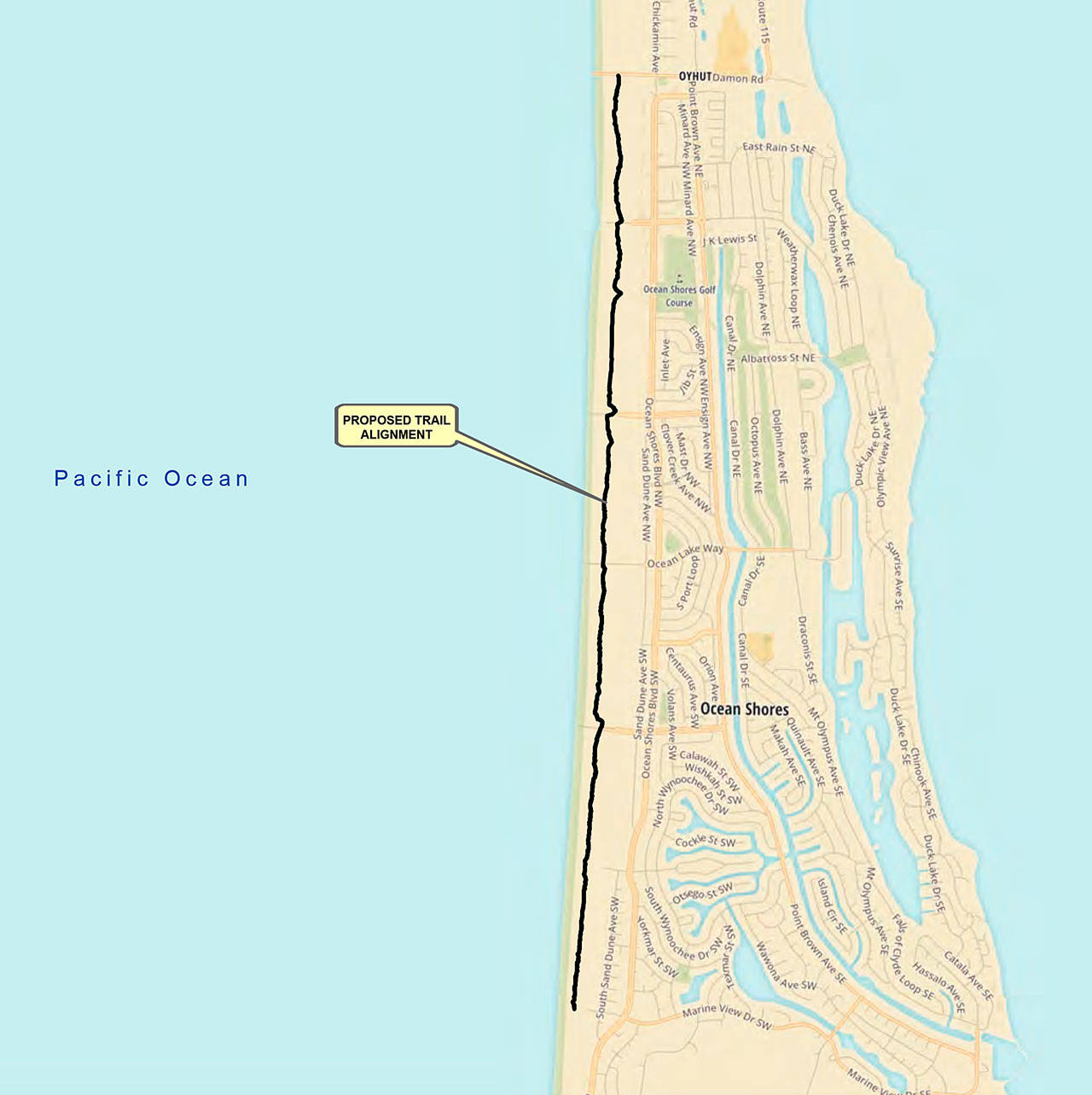The city of Ocean Shores will actively seek grant funding this May for the design and construction of a public access and fire-fighting access trail along the outer dunes, using a feasibility study prepared last year and discussed Monday during a special meeting at the Convention Center.
The study by GeoEngineers of Tacoma was commissioned to support the “city’s goal to fund and construct a non-motorized firebreak trail located on the vegetated dunes on the outer west coast of the city’s shoreline.”
“The trail is being considered for multiple purposes including possible vegetation and fire management, as well as non-motorized mixed-use access and recreation. The trail would improve the safety of residences and businesses from potential fires, as well as provide recreational and economic benefits through non-motorized access along the shoreline,” the study says. “It would also restrict the use and future development of ‘unmaintained’ paths through the dunes to the beach, thus reducing the impact to wetlands and other natural vegetation being caused by people damaging these sensitive areas.”
The plans also call for parking areas at trailhead access points, with design and construction for the project to be managed by the city’s Engineering and Planning Departments.
Funding looms as one of the biggest issues. On Monday, Mayor Crystal Dingler said the cost for the trail has been estimated to be about $1.7 million, with the city planning to construct it in phases.
The entire project would go from Damon Road by the Best Western Hotel to the access trail at Marine View Drive to the south.
“We obviously can’t do all of that all at once,” Dingler said.
The study states: “Funding for the project may come from a number of state, federal, and local sources as discussed in the report. The project has the support of several stakeholders and community groups including the City Council, Mayor, City Planning Commission, Community Firewise Team, Fire Department, and the Quinault Nation. If successfully funded and constructed, future phases of the project may include extending the trail north onto a portion of Grays Harbor County to include access to Ocean City State Park and the Quinault Beach Resort.”
The outline of the trail generally follows the crest of the so-called primary dune, which runs south-north along the outer coastline.
It extends approximately 4.5 miles between Damon Rd. and Marine View Dr. It would include a 110-foot buffer to limit the impact it would have on wetlands that have been detailed and verified within the area. The city also would have to show the trail conforms to the Shoreline Master Program, its own Comprehensive Plan and the North Beach Recreation Management Plan for the Ocean Beaches, as well as other state Ecology and federal regulations.
As far as funding sources, the study lists several options: “A number of different sources of funding are available for constructing non-motorized trails. The Washington State Department of Transportation (WSDOT) and the Washington Recreation Conservation Office (RCO) are two primary sources of grant funding for non-motorized trails in Washington State. The primary source of federal funding that is available through WSDOT to support trail funding is the Federal Highway Administration (FHWA) Transportation Alternatives Program (TAP).”
The project would include so-called dune grooming, which also would remove non-native plants such as Scotch broom. The intent also is to use prison labor to do much of the work, augmented by volunteers and city personnel.
Under the first phase, from Damon Road to Pacific Boulevard beach access, parking areas would be included, and the mayor asked the public to think of other needs, such as benches, signage along the trail, viewpoints, a possible amphitheater, or the types of surfaces, with asphalt having some preference over crushed rock or crushed oyster shells.
The trail, about 24,000 linear feet long, would essentially be just below the crest of the highest dune, estimated to be about 300 feet from the actual shoreline.
“We need to look at the wetlands and the buffers, and that’s a real serious point with the Department of Ecology,” Dingler said. “We want to do this in a way that is not really steep.”
The trail will be ADA compliant and allow for wheelchairs, strollers, bikes and walkers.
For fighting wildfires, Fire Chief David Bathke advocates placing large bladders filled with water in the dunes along with the trail rather than building a full water system, saving about $170,000.
“We can do this on a water supply that fits our needs,” Bathke said.
The city faces a May 1 deadline to apply for the Recreation Conservation Office grant. It calls for a four-year process to complete construction, with the grant not being awarded until July 2019.
Part of the 30 percent matching funds could be credited to local city labor and volunteer costs, as well as paid for through other grants, the mayor said.
“It will be a big project for us, but with the help of grants, I think it would make a big difference,” Dingler said.
Nearly everyone who spoke was in favor of the project: “I have been come down here for about 18 years, and have lived here for about the last four. I’m very impreseed with your presentation,” said Judy Hansey. “… I’d love for my grandkids to come here from West Seattle. But now they mostly go to Long Beach because of the accessibility.”



